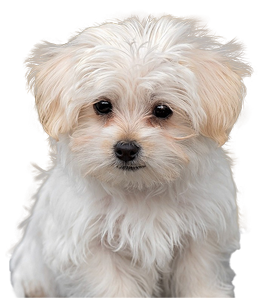
AKC Registrable
Apartment Friendly
Family Dog
Basset Hound
Among the most appealing of the AKC breeds, the endearing and instantly recognizable Basset Hound is a perennial favorite of dog lovers all over the world. This low-slung and low-key hound can be sometimes stubborn, but is always charming.
Available Pups
Puppy Knowledge
Breed Standard
Head
The head is large and well proportioned. Its length from occiput to muzzle is greater than the width at the brow. In overall appearance the head is of medium width. The skull is well domed, showing a pronounced occipital protuberance. A broad flat skull is a fault. The length from nose to stop is approximately the length from stop to occiput. The sides are flat and free from cheek bumps. Viewed in profile the top lines of the muzzle and skull are straight and lie in parallel planes, with a moderately defined stop. The skin over the whole of the head is loose, falling in distinct wrinkles over the brow when the head is lowered. A dry head and tight skin are faults. The muzzle is deep, heavy, and free from snipiness. The nose is darkly pigmented, preferably black, with large wide-open nostrils. A deep liver-colored nose conforming to the coloring of the head is permissible but not desirable. The teeth are large, sound, and regular, meeting in either a scissors or an even bite. A bite either overshot or undershot is a serious fault. The lips are darkly pigmented and are pendulous, falling squarely in front and, toward the back, in loose hanging flews. The dewlap is very pronounced. The neck is powerful, of good length, and well arched. The eyes are soft, sad, and slightly sunken, showing a prominent haw, and in color are brown, dark brown preferred. A somewhat lighter-colored eye conforming to the general coloring of the dog is acceptable but not desirable. Very light or protruding eyes are faults. The ears are extremely long, low set, and when drawn forward, fold well over the end of the nose. They are velvety in texture, hanging in loose folds with the ends curling slightly inward. They are set far back on the head at the base of the skull and, in repose, appear to be set on the neck. A high set or flat ear is a serious fault.
Body
The rib structure is long, smooth, and extends well back. The ribs are well sprung, allowing adequate room for heart and lungs. Flatsidedness and flanged ribs are faults. The topline is straight, level, and free from any tendency to sag or roach, which are faults.
Neck, Topline, Body
The rib structure is long, smooth, and extends well back. The ribs are well sprung, allowing adequate room for heart and lungs. Flatsidedness and flanged ribs are faults. The topline is straight, level, and free from any tendency to sag or roach, which are faults. The tail is not to be docked, and is set in continuation of the spine with but slight curvature, and carried gaily in hound fashion. The hair on the underside of the tail is coarse.
Forequarters
The chest is deep and full with prominent sternum showing clearly in front of the legs. The shoulders and elbows are set close against the sides of the chest. The distance from the deepest point of the chest to the ground, while it must be adequate to allow free movement when working in the field, is not to be more than one-third the total height at the withers of an adult Basset. The shoulders are well laid back and powerful. Steepness in shoulder, fiddle fronts, and elbows that are out, are serious faults. The forelegs are short, powerful, heavy in bone, with wrinkled skin. Knuckling over of the front legs is a disqualification. The paw is massive, very heavy with tough heavy pads, well rounded and with both feet inclined equally a trifle outward, balancing the width of the shoulders. Feet down at the pastern are a serious fault. The toes are neither pinched together nor splayed, with the weight of the forepart of the body borne evenly on each. The dewclaws may be removed.
Hindquarters
The hindquarters are very full and well rounded, and are approximately equal to the shoulders in width. They must not appear slack or light in relation to the over-all depth of the body. The dog stands firmly on its hind legs showing a well-let-down stifle with no tendency toward a crouching stance. Viewed from behind, the hind legs are parallel, with the hocks turning neither in nor out. Cowhocks or bowed legs are serious faults. The hind feet point straight ahead. Steep, poorly angulated hindquarters are a serious fault. The dewclaws, if any, may be removed.
Tail
The tail is not to be docked, and is set in continuation of the spine with but slight curvature, and carried gaily in hound fashion. The hair on the underside of the tail is coarse.
Size
The height should not exceed 14 inches. Height over 15 inches at the highest point of the shoulder blade is a disqualification.
Color
Any recognized hound color is acceptable and the distribution of color and markings is of no importance.
Coat
The coat is hard, smooth, and short, with sufficient density to be of use in all weather. The skin is loose and elastic. A distinctly long coat is a disqualification.
Gait
The Basset Hound moves in a smooth, powerful, and effortless manner. Being a scenting dog with short legs, it holds its nose low to the ground. Its gait is absolutely true with perfect coordination between the front and hind legs, and it moves in a straight line with hind feet following in line with the front feet, the hocks well bent with no stiffness of action. The front legs do not paddle, weave, or overlap, and the elbows must lie close to the body. Going away, the hind legs are parallel.
Disqualifications
Height of more than 15 inches at the highest point of the shoulder blade. Knuckled over front legs. Distinctly long coat.
Overview
Group
Hound
Temperament
Charming, Patient, Low-Key
About
The Basset Hound stands no higher than 14 inches at the shoulder but, with his remarkably heavy bone, powerful little legs, and massive paws, he possesses big-dog strength and stamina. Bassets are famous for a large, domed head that features extremely long, velvety ears, mournful eyes, and a wrinkled brow, which give the breed the look of a sad clown. Built more for endurance than speed, the Basset moves in a deliberate but effortless manner. The breed’s scenting ability is uncanny; it’s said that among dogs only the nose is more accurate. Mild and agreeable at home, the Basset is stubborn on the trail and barks in a loud, ringing voice. Although they may not be wildly demonstrative in their affections, they are steadfastly loyal.
History
Basset Hounds were originally bred in France and Belgium (“basset” is French for “low”). It is thought that the friars of the Abbey of St. Hubert were responsible for crossing strains of older French breeds to create a low-built scenting hound that could plod over rough terrain while followed on foot by a human hunting partner tracking rabbit and deer. Their accuracy and persistence on scent made Bassets a popular choice for French aristocrats, for whom hunting was a way of life.
Standard
The Basset Hound possesses in marked degree those characteristics which equip it admirably to follow a trail over and through difficult terrain. It is a short-legged dog, heavier in bone, size considered, than any other breed of dog, and while its movement is deliberate, it is in no sense clumsy. In temperament it is mild, never sharp or timid. It is capable of great endurance in the field and is extreme in its devotion.
Nutrition
The Basset Hound should do well on a high-quality dog food, whether commercially manufactured or home-prepared with your veterinarian’s supervision and approval. Any diet should be appropriate to the dog’s age (puppy, adult, or senior). Some dogs are prone to getting overweight, so watch your dog’s calorie consumption and weight level. Treats can be an important aid in training, but giving too many can cause obesity. Learn about which human foods are safe for dogs, and which are not. Check with your vet if you have any concerns about your dog’s weight or diet. Clean, fresh water should be available at all times.
Grooming
Although it might seem that with his short, smooth hair the Basset Hound won’t need any grooming, that’s not quite the case. Regular grooming sessions are an important part of keeping the breed healthy and happy. The Basset’s short hair can shed profusely. Shedding can be kept under control by gently going over the dog at least once a week with a soft brush or a shedding tool. As well as removing hair that is ready to shed, grooming is like an all-body massage that benefits his skin and overall health. The Basset will also need his nails trimmed regularly, and an occasional bath will help to keep his coat clean and shiny.
Exercise
Basset Hounds are not as active as some breeds, but they do require regular, moderate exercise. Usually a daily walk at a moderate pace will fill the bill. Exercise will help to keep the Basset healthy and prevent him from becoming overweight. Since the breed was developed to work in a pack with other dogs, Bassets enjoy canine company on their outings, and the breed can be quite playful. After a walk or play session they’ll typically settle down for a comfortable sleep.
Training
Basset Hounds are very independent, and training the breed can be a challenge. Over the centuries, scenthounds of this type were developed to hunt on their own and to follow a track without distraction. Because of this, they can seem aloof and not interested in following your commands. However, a Basset definitely can be trained—it will just take time, consistency, and persistence. Using treats and early socialization in puppyhood is crucial, and as the Basset matures he and his owner can benefit from continued positive obedience training.
Health
Because of the Basset’s ears are long and droopy, it’s important to check them frequently to ensure that air circulation hasn’t led to an infection. Shaking the head or scratching at the ears may indicate the need for a vet visit. Responsible breeders check for health conditions such as hip dysplasia, elbow dysplasia, glaucoma, hypothyroidism, bleeding disorders, and luxating patella, a dislocated kneecap once called a “trick knee” in humans. Brushing your dog’s teeth with specially formulated canine toothpaste at least twice a week is also a vital part of Basset health care.




